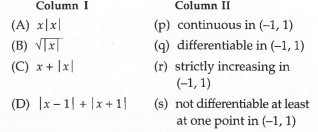In the following, [x] denotes the greatest integer less than or equal to x. Match the functions in Column I with the properties Column II.
Column IColumn II(A)x|x|(p)continuous in (-1, 1)(B)√|x|(q)differentiable in (-1, 1)(C)x+[x](r)strictly increasing (-1, 1)(D)|x−1|+|x+1|(s)not differentiable at least at one point in (-1, 1)
Step by step video & image solution for In the following, [x] denotes the greatest integer less than or equal to x. Match the functions in Column I with the properties Column II. {:(,"Column I",,"Column II"),((A),x|x|,(p),"continuous in (-1, 1)"),((B),sqrt(|x|),(q),"differentiable in (-1, 1)"),((C),x + [x],(r),"strictly increasing (-1, 1)"),((D),|x-1|+|x + 1|,(s),"not differentiable at least at one point in (-1, 1)"):} by Maths experts to help you in doubts & scoring excellent marks in Class 12 exams.
Updated on:21/07/2023Topper's Solved these Questions
Similar Questions
In the following, [x] denotes the greatest integer less than or equal to x.
Column IColumn IIAx|x|pcontinuous in (-1, 1)B√|x|qdifferentiable in (-1, 1)Cx+[x]rstrictly increasing (-1, 1)D|x−1|+|x+1|, in(−1,1)snot differentiable atleast at one point in (-1, 1)
View SolutionIn the following, [x] denotes the greatest integer less than or equal to x.
Column IColumn IIA.x|x|p.continuous in (-1, 1)B.√|x|q.differentiable in (-1, 1) C.x+[x]r.strictly increasing (-1, 1)D.|x−1|+|x+1| in (-1,1)s.not differentiable atleast at one point in (-1, 1)
View Solution
Knowledge Check
Let [x] denote the greatest integer less than or equal to x. Then, ∫−11[x]dx=?
A−1B0C12D2Let [x] denotes the greatest integer less than or equal to x if x=(√3+1)5then [x] is equal to
A50B76C51D152If [x] denotes the greatest integer less than or equal to x,then the value of limx→1(1−x+[x−1]+[1−x]) is
A0B1C−1Dnone of these
In the following [x] denotes the greatest integer less than for equal to x. Match the functions in Column I with the properties in Column II and indicate your answer by darkening the appropriate bubles in the 4×4 matrix.

View SolutionLet [x] denote the greatest integer less than or equal to x. If x=(√3+1)5, then [x] is equal to
View SolutionIf [x] denotes the greatest integer less than or equal to x,then the value of limx→1(1−x+[x−1]+[1−x]) is
View SolutionThe domain of the function f(x)=cos−1[secx], where [x] denotes the greatest integer less than or equal to x, is
View SolutionIf I=∫1−1{[x2]+log(2+x2−x)}dx where [x] denotes the greatest integer less than or equal to x, the I equals
View Solution
